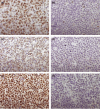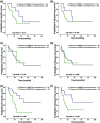DNA methyltransferase DNMT3b protein overexpression as a prognostic factor in patients with diffuse large B-cell lymphomas
- PMID: 20398054
- PMCID: PMC11159814
- DOI: 10.1111/j.1349-7006.2010.01569.x
DNA methyltransferase DNMT3b protein overexpression as a prognostic factor in patients with diffuse large B-cell lymphomas
Abstract
Diffuse large B-cell lymphomas (DLBCL) are the most common type of aggressive lymphomas, with considerable heterogeneity in clinical presentation, molecular characteristics, and outcome. Previous studies have showed significant correlations between DNA methyltransferase (DNMT) overexpression and unfavorable prognosis in human cancers. Therefore, we investigated in this study the biological and prognostic significance of DNMT1, DNMT3a, and DNMT3b protein expression in DLBCL. DNA methyltransferase (DNMT) expression was analyzed by immunohistochemistry in 81 DLBCL cases and correlated with clinicopathological parameters. Kaplan-Meier curves were used to estimate survival rates, and the Cox proportional hazard regression model was used to evaluate the prognostic impact of DNMT expression. Our results showed that overexpression of DNMT1, DNMT3a, and DNMT3b were detected in 48%, 13%, and 45% of investigated cases, respectively. DNA methyltransferase 1 (DNMT1) and DNMT3b overexpression was significantly correlated with advanced clinical stages (P = 0.028 and P = 0.016, respectively). Moreover, concomitant expression of DNMT1 and DNMT3b was significantly correlated with resistance to treatment (P = 0.015). With regard to survival rates, although data was available only for 40 patients, DNMT3b overexpression was significantly correlated with shorter overall survival (P = 0.006) and progression-free survival (P = 0.016). Interestingly, multivariate analysis demonstrated that DNMT3b overexpression was an independent prognostic factor for predicting shortened overall survival (P = 0.004) and progression-free survival (P = 0.024). In conclusion, DNMT3b overexpression was identified as an independent prognostic factor for predicting shortened survival of patients with DLBCL and could be, therefore, useful in identifying patients who would benefit from aggressive therapy.
Figures


References
-
- Swerdlow SH, Campo E, Harris NL et al. WHO Classification of Tumours of Haematopoietic and Lymphoid Tissues. In: Press I, ed. IARC WHO Classification of Tumours, Lyon: WHO, 2008; 171–4.
-
- Lossos IS, Morgensztern D. Prognostic biomarkers in diffuse large B‐cell lymphoma. J Clin Oncol 2006; 24: 995–1007. - PubMed
-
- Gascoyne RD. Emerging prognostic factors in diffuse large B cell lymphoma. Curr Opin Oncol 2004; 16: 436–41. - PubMed
-
- Shipp MA, Harrington DP, Anderson JR et al. A predictive model for aggressive non‐Hodgkin’s lymphoma. The International Non‐Hodgkin’s Lymphoma Prognostic Factors Project. N Engl J Med 1993; 329: 987–94. - PubMed
-
- Alizadeh AA, Eisen MB, Davis RE et al. Distinct types of diffuse large B‐cell lymphoma identified by gene expression profiling. Nature 2000; 403: 503–11. - PubMed
Publication types
MeSH terms
Substances
LinkOut - more resources
Full Text Sources
Other Literature Sources

